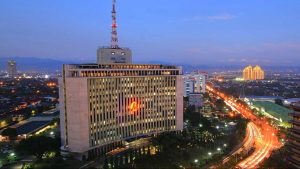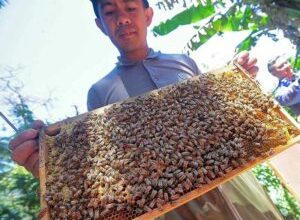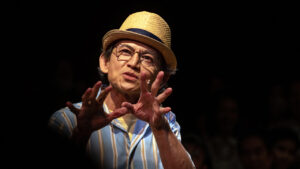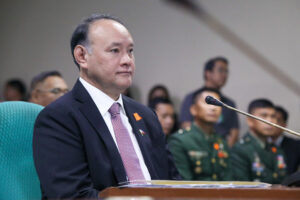PICC and its artworks declared National Cultural Treasures
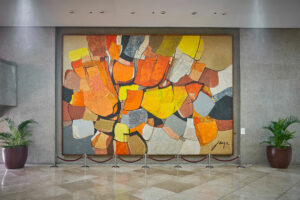
ARCHITECT Andy Locsin recalled how very busy his father, National Artist for Architecture Leandro V. Locsin, was when he was tasked to work on what is known to be his magnum opus, the Philippine International Convention Center (PICC) in Pasay City, during the 1970s. The construction was rather quick, finished within 23 months from November 1974 to September 1976.
Even as a young boy, “We were all very aware with these buildings growing up, of how busy the office was, and how tense and how under the gun everybody was to get these things complete. There was a lot of pressure,” Mr. Locsin recalled. “At the time, things had to be done in very short order, very quickly, and decisiveness was critical. So, [it was] not an easy time, but a super exciting time, [a] very creative time.”
Inaugurated on Sept. 5, 1976, the building was created to host the International Monetary Fund and World Bank meetings. Artworks and furniture were commissioned for the building, done by creative minds who would later be named National Artists.
This year, the PICC and its four original commissioned artworks have been named National Cultural Treasures (NCT).
CHOOSING NATIONAL TREASURESOn June 27, 2019, a panel of experts was convened by National Museum of the Philippines Director Jeremy R. Barns, to evaluate and decide which cultural properties should be designated as National Cultural Treasures and Important Cultural Properties.
The panel resolved that the PICC Complex — National Artist Leandro Locsin’s magnum opus — together with the concrete sculpture Anito at the PICC Courtyard and the steel sculpture Grid at the Plenary Hall and Reception Hall Lobby, both by National Artist for Visual Arts Arturo R. Luz, the abstract painting Pagdiriwang at the Delegation Upper Lobby by National Artist for Visual Arts Jose T. Joya, and the carved wooden furniture distributed in the PICC’s lobbies and hallways, all by National Artist for Sculpture Napoleon V. Abueva, qualified for the status of National Cultural Treasure.
The official public declaration of the PICC Complex and its permanently installed works of art as National Cultural Treasures was held on Sept. 27 at the PICC Main Lobby. The unveiling of the National Cultural Treasure marker and the signing of the certificate of turnover and acceptance during the ceremony, coincided with the PICC’s anniversary month.
“This came as a surprise to us actually,” PICC General Manager Renato B. Padilla told BusinessWorld shortly after the ceremony. “The National Museum commissioned a panel of experts. We did not even know that they are moving around. So, when they wrote us, it was a surprise.”
The PICC has hosted over 15,000 events since its inauguration, including international summits, commencement exercises, and corporate and government meetings. The building’s design is a Locsin trademark, with the use of concrete floating volume and simple design for its brutalist architectural style.
The PICC, along with other structures the CCP Complex, have been associated with what was called the former first lady Imelda Marcos’ “edifice complex.”
THE FOUR ARTWORKSMeasuring 7 meters by 5.5 meters, Jose Joya’s oil on canvas painting, The Padiriwang, is considered one of the largest abstract paintings on display in the Philippines. Located at the wall of the Center’s Upper Lobby, the painting uses Mr. Joya’s impasto technique and strong colors.
Arturo Luz’s Anito is made of cast concrete and metal, and serves as a centerpiece of the courtyard. It has a height of 10.28 meters, including the concrete base.
Mr. Luz’s other sculpture, Grid, is made of nonmagnetic satin steel and is shaped like an octothorpe. It is mounted above the grand staircase of the Plenary Hall and Reception Hall Lobby.
Napoleon Abueva’s wooden benches are made of laminated narrow wood, with a curved seat base and polished stainless steel sheet pressure bonded to the wood base. The 93 benches — which is a unique feature of the Center — come in two versions. The three-seater bench is rectangular, and the four-seater is a squarish piece of furniture.
The artworks join the list of other National Cultural Treasures which includes paintings by Félix Resurrección Hidalgo, Carlos “Botong” Francisco, and Juan Luna, and heritage structures like the San Sebastian Church and the Metropolitan Theater.
“When these buildings were launched, we were brought here by my dad and my mom during the openings and when buildings were in operation,” the younger Mr. Locsin said. “We were, of course, just as amazed as the next person who came into the spaces because nothing like this had ever been done at that point.”
“At the time, it was my dad’s largest commission.”
“A lot of the art and the architecture actually really went together,” he said. “There was a certain kind of design thinking and an aesthetic that they share. Modernism, cubism, and how space is handled — these were the sorts of things they talked about.”
ON CULTURAL PROPERTIESAccording to RA 10066 or the National Heritage Act of 2009, a National Cultural Treasure refers to “a unique cultural property found locally, possessing outstanding historical, cultural, artistic and/or scientific value which is highly significant and important to the country and nation, and officially declared as such by pertinent cultural agency.”
All cultural properties declared as national cultural treasures are entitled to privileges such as “priority government funding for protection, conservation and restoration,” especially in the event of armed conflict or natural disaster. An official heritage marker is also placed by the cultural agency concerned “indicating that the immovable cultural property has been identified as national cultural treasures.” The property shall be accessible to public and “be given the right of first refusal in the purchase” by an appropriate cultural agency.
“One of the mandates of the National Museum is to help highlight what among everything in the country is really worth taking note of in terms of our cultural, artistic, historical heritage,” the National Museum’s Mr. Barns told members of the press after the ceremony.
“It’s important that we realized that the PICC is significant in artistic terms, also historically because of all the events that happen here and continue to happen, and for people to take an opportunity to visit….,” he added.
Future collaborations with the National Museum, Mr. Padilla said, will focus on the PICC’s art. “We will collaborate with National Museum in showcasing all the art pieces here because there are more.” — Michelle Anne P. Soliman
